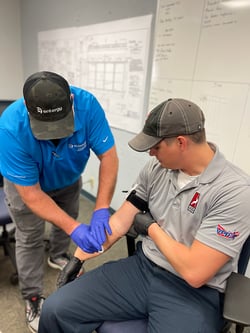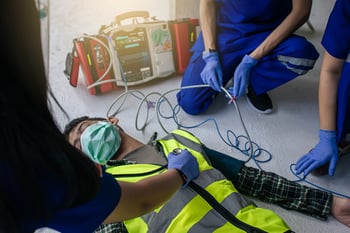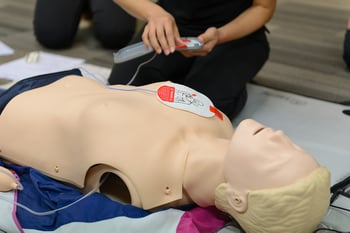Confined Space Rescue Is Just Ropes, Right? I’m a-Frayed Knot.
 So, you’ve got your rescue team up to date on all the nifty tricks in confined space rescue. Litters, knots, anchoring, mechanical advantage systems, the whole kit, and kaboodle. Now, you’ll need some first aid and CPR training to meet OSHA’s standards. Some folks say a simple layperson first aid course will do it. Others argue that teams need a week-long EMS professional course to prepare. Going further, some folks say that investing in drills and skills retention is the most critical issue. To cut through some confusion, let’s look at some of the things employers might factor in when choosing medical training for Emergency Response and Rescue Teams.
So, you’ve got your rescue team up to date on all the nifty tricks in confined space rescue. Litters, knots, anchoring, mechanical advantage systems, the whole kit, and kaboodle. Now, you’ll need some first aid and CPR training to meet OSHA’s standards. Some folks say a simple layperson first aid course will do it. Others argue that teams need a week-long EMS professional course to prepare. Going further, some folks say that investing in drills and skills retention is the most critical issue. To cut through some confusion, let’s look at some of the things employers might factor in when choosing medical training for Emergency Response and Rescue Teams.
What’s the Standard?
OSHA 1910.146(k) requires that employers “Train affected employees in basic first-aid and cardiopulmonary resuscitation (CPR),” and “ensure that at least one member of the rescue team or service holding a current certification in first aid and CPR is available.” That’s a lot, so let’s take a second to dissect this by defining some terms. According to OSHA, “First aid refers to medical attention that is usually administered immediately after the injury occurs and at the location where it occurred. It often consists of a one-time, short-term treatment and requires little technology or training to administer.” Alright, that’s pretty straightforward.
 Now, let’s take a look at CPR or Cardiopulmonary Resuscitation. Simply put, rescuers will perform chest compressions to pump blood around the body and typically breathe for the patient. But wait, don’t I need to shock the patient? What about the AED (Automated External Defibrillator)? Am I required to have an AED in my first aid supplies? A 2004 letter of interpretation says no, AEDs are not specifically required in the rescue team first aid kit. However, AED’s are much easier to use today and an abundance of research says you probably should include one in your kit.
Now, let’s take a look at CPR or Cardiopulmonary Resuscitation. Simply put, rescuers will perform chest compressions to pump blood around the body and typically breathe for the patient. But wait, don’t I need to shock the patient? What about the AED (Automated External Defibrillator)? Am I required to have an AED in my first aid supplies? A 2004 letter of interpretation says no, AEDs are not specifically required in the rescue team first aid kit. However, AED’s are much easier to use today and an abundance of research says you probably should include one in your kit.
Here's why you may want to consider an AED. According to the American Heart Association, every minute after cardiac arrest without defibrillation, the patient’s chances of survival decrease by 7%-10%, and after 12 minutes, survival rates are as low as 2%-5%. In their 2020 guidelines, the AHA adds, “Defibrillation is most successful when administered as soon as possible after onset of VF/VT (lethal cardiac arrhythmias) and a reasonable immediate treatment when the interval from onset to shock is very brief. Conversely, when VF/VT is more protracted, depletion of the heart’s energy reserves can compromise the efficacy of defibrillation unless replenished by a prescribed period of CPR before the rhythm analysis.” If you have an AED handy, the rescue team is more likely to successfully resuscitate the patient rather than waiting for EMS or for someone to retrieve it from across the site.
Now that we’ve translated the standard let’s differentiate two of the most common training course types for rescue teams: Layperson First Aid and EMS/EMR Professional.
Professional Courses vs Layperson Courses

Although the topics and skills taught in basic first aid courses and EMS professional courses are similar, each route has unique advantages and disadvantages. For instance, and obvious to most folks doing the shopping, the price and time commitments vary. Typically, a simple layperson first aid course takes one day with around 4 to 10 hours of total time with the instructor. The American Heart Association, National Safety Council, American Red Cross, and other nationally recognized organizations offer First Aid CPR and AED credentials. So, although you’re only committing a single day you can trust, in most cases, that the information is solid to give your personnel a knowledge of the basics.
However, if you want your emergency response personnel to be able to take greater lifesaving measures, we highly recommend an Emergency Medical Responder (EMR) course. This is especially true if you are located in an industrial site with numerous hazards and possibly isolated from immediate medical care.
In an EMR course students will get around 50 hours of instruction, practice, and evaluation. According to the National Registry, “EMRs have the knowledge and skills necessary to provide immediate lifesaving interventions while awaiting additional EMS resources to arrive. EMRs also provide assistance to higher-level personnel at the scene of emergencies,” EMR is one of the most common medical certifications amongst both volunteer and professional responders. They are typically regulated by a state EMS education agency and taught by private businesses with licensed instructors.
From my personal experience as a Paramedic, I can say that receiving a patient from a layperson with first aid and a trained EMR can make a big difference. Oftentimes, this increases the viability of the patient – especially when access to professional medical care is not immediately available. The assessment taught to Emergency Medical Responders is almost identical to the scene assessment and patient surveys an EMT or Paramedic performs when responding to an emergency. As a component of your emergency response, medical care for the patient must be assessed and considered a vital part of any successful rescue operation.
Drills and Skills Retention
 If you don’t use it, you lose it. Regardless of the course, the most critical component of any program is drilling and skills retention. In a 2020 study, a group of medical students went through a 40-hour BLS course. Immediately after training, 78% of the students were evaluated and categorized as “excellent.” However, 6 short months after the training, that number dropped to 40%.
If you don’t use it, you lose it. Regardless of the course, the most critical component of any program is drilling and skills retention. In a 2020 study, a group of medical students went through a 40-hour BLS course. Immediately after training, 78% of the students were evaluated and categorized as “excellent.” However, 6 short months after the training, that number dropped to 40%.
What does this mean for your team? Should they retrain every 6 months? Maybe we could simplify their training to aid in retention. Research conducted by the European Resuscitation Council (ERC) in 2019 showed an increase in 3-month skill retention after simplifying their guidelines. The simplest answer I can provide is to do what’s best for your unique situation.
Take a look at the hazards on your site, take note of the possible conditions and injuries, and perform a full-speed drill as often as you feel your team needs to stay proficient. If the one-year minimum for your confined space program shows a severe lack in team performance, try 6 months. If twice a year still reveals major gaps, move to 3 or even 4 exercises a year. The fact is, if you find the issues after someone is hurt or killed, the money, time, and resources you save will be nothing compared to the lives that are changed by the tragedy.
The best day to perform a rescue is the day after class. The rust builds up a bit every day that goes by. So, be proactive, aggressively shop the right course for you, and plan on investing heavily in site hazard-specific drills and rescue exercises that involve first aid and CPR. The families that work for you are betting their lives on it.
Conclusion
There are a lot of medical courses out there to choose from. What level of medical care do you want your team to have? One of a layperson to cover the basics or an EMS professional that sees the bigger picture of patient outcome and the continuum of care. Either way, if you don’t take your training seriously and prepare drills for your specific needs, the chances of catastrophe increase by the day. So, invest in your workforce's safety and peace of mind, give them the tools and perspective they need to be successful, and train hard.
References
1.https://www.osha.gov/laws-regs/standardinterpretations/2004-06-17-0
2.https://www.osha.gov/sites/default/files/publications/OSHA3317first-aid.pdf
3.https://www.osha.gov/medical-first-aid/standards
4.https://www.osha.gov/medical-first-aid/recognition
5.https://www.ncbi.nlm.nih.gov/pmc/articles/PMC2600120/#ref19
6.https://www.ahajournals.org/doi/full/10.1161/circ.102.suppl_1.I-22
7.https://www.ahajournals.org/doi/10.1161/circ.140.suppl_2.139
Additional Resources




